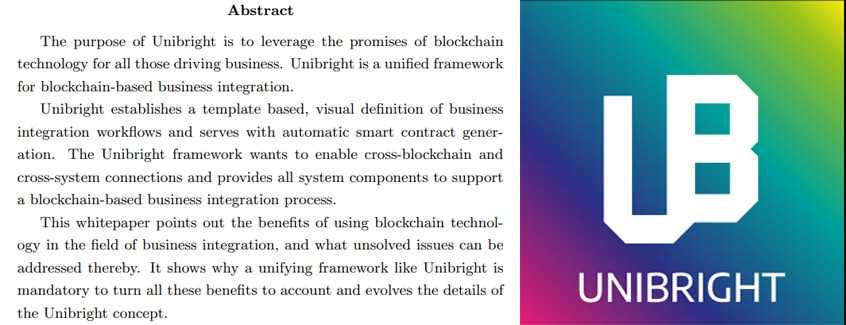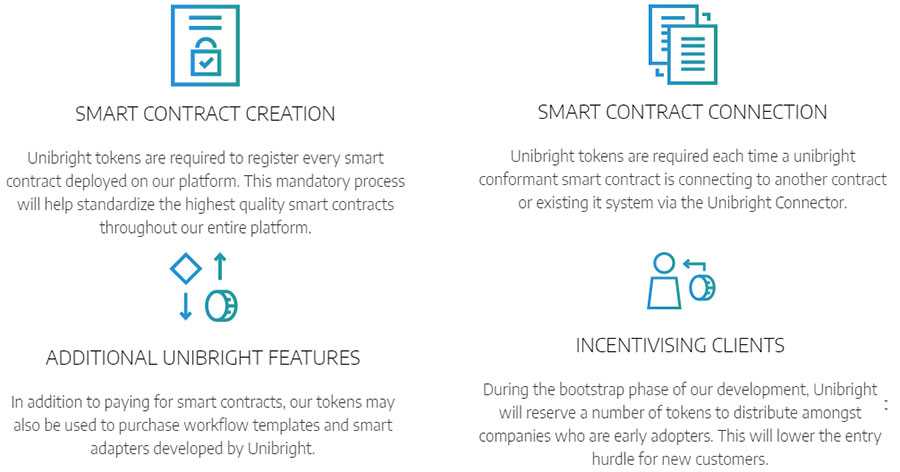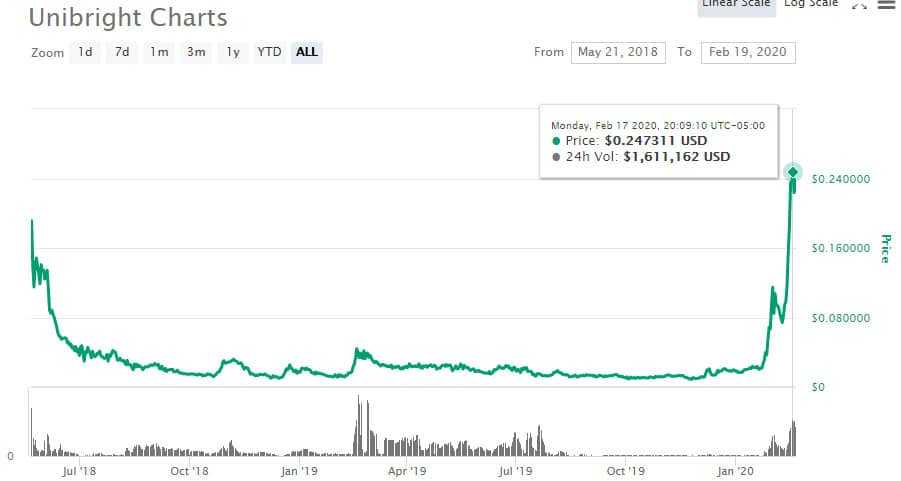Unibright Review: Powering Enterprise Blockchain Adoption
Unibright is a project that has been generating quite a bit of interest recently. So much so that the UBT token has been rallying in price as traders have been snapping it up.
However, behind the impressive performance is a really interesting project that is looking to take enterprise blockchain adoption to the next level. Unibright is also looking to be the connecting fiber between the open source Ethereum network and companies.
So, is it really worth considering?
In this Unibright review, I will attempt to answer that. I will also take a look at the long term use cases and adoption potential of the UBT Token.
What is Unibright?
Unibright is a fairly new blockchain project that's self-described as the “unified framework for blockchain based business integration.” Whew! That's quite a mouthful, but what exactly does it mean, and how can we use Unibright?
In essence Unibright is being created to give companies and other organizations the ability to utilize blockchain technology without the extensive costs, huge hassle, and the need for a large corps of developers.

Instead businesses are able to use the visual workflow created by Unibright to create and launch smart contracts on an appropriate blockchain. And it can all be done without any coding skills whatsoever. There's no blockchain skills required, no smart contract development knowledge, not even traditional software development knowledge is needed.
Unibright has even gone to the trouble of including a number of business use cases right within the system. These include cases such as invoicing, shipping process monitoring, asset life cycles, multi-party approvals, and many others.
Users can easily select their use case and then create a custom workflow. This can then be deployed in a way to bridge the information between the new blockchain and existing systems, such as ERP.
Unibright Objectives
One of the key roadblocks to the adoption of blockchain technology by enterprises has been the concerns around the usability of existing solutions, and the huge knowledge gap that exists in regards to deploying, developing, and designing blockchain solutions.
Add to this the scarcity of talented blockchain developers and the cost of hiring such talented developers. It's understandable that businesses have been slow to adopt blockchain solutions, even though many business leaders are able to see the potential for blockchain to dramatically improve their operations.
The blockchain solutions being created often have clear advantages for businesses, but traditional businesses have been slow to adopt these new and novel solutions. The uncertainties regarding costs, development, and effectiveness in blockchain integration has kept many on the sidelines.

And that's why Unibright was developed and where it comes into play.
The Unibright project is attempting to position itself as a unified framework that simplifies all the aspects of blochcain integration for enterprises through its algorithmic design.
Through this framework businesses can take advantage of interoperability, not only between blockchains, but also with legacy systems. Unibright provides a full stack of tools that function to connect information between all systems, increasing the productivity and efficiency of an organization.
One of the beauties of the Unibright platform is it's blockchain agnostic. It tries to use visual cues and more abstract designs to describe integration scenarios for businesses and to make them as cost-efficient and easy to implement as possible. The platform has also attempted to remain flexible in regard to technological advancements in blockchain.
Unibright Technology
In the simplest terms the Unibright platform was created as a simple framework that individual businesses can mold to their own specific needs.
It will allow managers to use blockchain solutions in their everyday operations with little risk, while saving costs and increasing productivity and efficiency. Unibright is designed to finally close the gap between blockchain technology and traditional business applications.
The Unibright framework currently contains four distinct tools:
The UB Workflow Designer
This tool allows anyone, even those with no blockchain experience or knowledge, to define workflows visually, and without any reference to a specific blockchain protocol. The UB Workflow Designer allows its users to choose an existing template and them customize it to their workflow needs.

This visual designer can even define integrations with other blockchains and IT systems, as well as setting system boundaries. Once the workflow has been created the system automatically generates the needed smart contracts with the necessary business logic.
The UB Contract Interface
This is the central part of Unibright's ecosystem. With the UB Contract Interface users are able to make changes to previously designed workflows, transforming them into smart contracts specific to a blockchain. They can then publish the smart contracts, maintain them, or automatically generate templated connection adapters for existing systems.

The templates that are made available to users of the Unibright ecosystem have been designed around predefined business workflows, and are presented at a high level of abstraction. The development team plans on maintaining the templates, enhancing them as needed, and creating new templates to serve new use cases and industries.
The UB Explorer
The UB Explorer provides a simple interface where users can monitor all ongoing processes. Data is collected from the smart contracts, as well as from any systems that have been connected to the chosen template.

The Explorer provides Smart Queries that present useful information and are automatically generated based on the specific workflows. This way both on-chain and off-chain data can all be presented together in an easy to read and extremely useful dashboard.
The UB Connector
This is how Unibright allows off-chain systems to access and use Unibright smart contracts. It also enables the creation of cross-chain workflows, and cross-system workflows.

It does this through the Smart Adapter, which takes all the technical details needed to connect a blockchain or ERP system and transforms them to allow the connection to happen. Smart Adapters make the Unibright Connector dynamic, and enable a massive variety of integration possibilities.
Unibright Team
Unibright and its team are based in Germany and led by founder and CEO Marten Jung. Marten has also been the CEO of the parent company SPO Consulting for the past two years. SPO Consulting has been in business for over 20 years, with a focus on business integration.
The co-founder and CTO of Unibright is Stefan Schmidt. He also serves as the Head of Software Architecture. The Lead Frontend Engineer for the project is Ingo Sterzinger, who brings over a decade of software development experience to Unibright.

In addition to these three there are an additional four core positions, with the following titles mentioned: Chief Communications Officer, CMO and Head of Marketing, Lead Engineer Testing, and Lead Engineer Data Modeling.
These positions are all filled with members who have many years of experience in database management, engineering, and computer science. The only potential downside is that none of the team members have any prior blockchain experience. However they all seem accomplished enough to acquire the skills they need to succeed rapidly.
Advisors & Partners
Besides having a very skilled set of team members, Unibright also has a very skilled and knowledgable team of advisors.
This group brings a wealth of blockchain experience and knowledge to the project and includes Youtuber and founder of DataDash Nicolas Merten. In addition there are a number of former PwC auditors, blockchain developers from Ambisafe and Iconiqlab, PhDs, and venture capitalists.
Unibright has also been aggressive in developing partnerships, including SAP, Microsoft, Iconiqlab, and Ambisafe among others. This puts the project in a good position to strengthen their market exposure and positioning.

They’ve also gotten together with Deutsche Bahn to create a tokenized ecosystem for public transportation. And most recently they’ve entered into a strategic partnership with NEM. In addition, the parent company SPO Consulting has business relationships with companies such as Lufthansa, Unilever, and Samsung that can be leveraged in the coming years.
UBT Token
Accessing the Unibright framework requires UBT tokens. Users deposit whatever number of tokens required for their usage. To acquire tokens users must buy them on the open market. Unibright even offers to help if the users need assistance in purchasing through an exchange.
There were some concerns expressed by the Unibright community at this setup, as some felt that large enterprises couldn't be expected to go to an exchange to purchase tokens, but this hasn't been a problem to date and all users have been able to acquire whatever tokens they need from IDEX.
This 30 days of usage is a crucial part of the UBT token model. It was setup so that a users initial deposit must be large enough to cover a minimum of 30 days usage. This allows them to later make use of a “Rebuy contract.”
This is key because it allows customers to repurchase the tokens they used over the 30 day period from Unibright to continue using their blockchain integration. The Rebuy contract determines the rebuy price, with the standard set at $0.14 per UBT.

This price may seem low to some, but in truth this is how enterprise solutions are often costed. In practice the initial purchase and deposit is likely to be the most expensive part of the process. This makes complete sense since the initial deposit is like the setup cost for the process. Currently the price of one UBT is above the $0.14 level, making the Rebuy contracts very useful from a business standpoint.
Once tokens are deposited to the platform, and this includes rebought tokens, they cannot be withdrawn again. When tokens are deposited and the Rebuy Contract is signed the tokens are locked in a smart contract which lasts for the duration of the contract.
The good news for investors is that every additional Unibright user removes more UBT tokens from the open market. This should help support UBT prices in the future as increased demand will lead to declining supply.
What happens when the contract ends?
Once the contract ends the user needs to deposit more tokens which they've purchased on the open market. They sign a new contract and these tokens are then locked into the platform. This means new tokens must be purchased each time a Rebuy Contract expires.
What about the tokens from the expired contracts?
These tokens go back to Unibright. Initially the plan was to sell these tokens on the open market to create additional revenue for the project. That plan has been set aside thankfully, and the team has decided not to sell the tokens they receive, ever.
Instead the plan is to use these tokens to onboard non-profit organizations to the platform. These tokens are not being gifted, but will be deposited into the framework to help the charities to benefit from the blockchain integrations that have been made available.
In essence this means that any token deposited into the framework will be forever removed from the open market, and thus the circulating supply of UBT tokens will be forever declining.
UBT Trading & Storage
After the project held their ICO in May 2018, raising $13.54 million by selling roughly two-thirds of the UBT supply for $0.14 each investors were rewarded with an immediate pump to almost $0.19 each. That didn’t last long though, and by the end of May the price of UBT was slightly below the ICO price. The token continued to decline, nearly reaching $0.01 by October 2018.
Price bounced around slightly after that, rarely topping $0.02 and also not going below $0.01. By the end of 2019 the price of UBT was still stuck stubbornly below $0.02.
As the entire universe of altcoins began climbing in 2020, so too did UBT begin to rally. From just below $0.02 at the start of the year the token price has soared to an all-time high of $0.28922 as of February 18, 2020.

When it comes to exchange coverage, UBT does not appear to have that much support. Hotbit has over 60% of the trading volume which means that it is quite centralised. The liquidity also appears to be quite limited which means that you will experience slippage when trading large block orders.
Because UBT is an ERC-20 token you can use any wallet that’s suitable for storing ERC-20 tokens. Some suggestions would be the Ledger and Trezor hardware wallets, MyEtherWallet, MetaMask, Atomic, and many others.
Development Progress & Roadmap
2019 was quite a busy year for the Unibright team. There were a number of technical advancements that they brought to the fore as well as some partnerships. These include the following:
- Q1: They brought the UniBright framework to product readiness (earlier than initially). They also joined the European Blockchain Foundation
- Q2: There was further collaberation with Universities and other academic institutions. On the product front, they released the C02 compensation project for "Carbonara".
- Q3: They integrated Facebook's Libra technology into the Unibright framework. There was also some work on the tokenization of securities.
- Q4: Perhaps the most meaningful announcement here was their official partnership with Digital and Anyblock Analytics.
While Unibright does not have an updated roadmap on their website, they do have this blog post that was published in April of last year. As you can see, there are a number of goals they would like to achieve by the end of this year and by the end of 2024.
By the end of 2020, they would like to achieve the following:
- On-boarding More clients: They also would like to lock 15-25% of UBT inside the platform.
- Development on Automatic Setup: This would allow clients to set up a Unibright Framework SaaS environment, for locking in tokens and enabling token renewal by smart contract
Then, the singular goal that they would like to acheive by 2024 is enable mass adoption as they target to lock up 80% of the UBT inside the platform.
Final Thoughts
By looking for ways to offer blockchain technology in a simple manner to businesses and enterprises Unibright is taking on one of the most critical areas to the adoption of blockchain technology.
Businesses need this new technology for its productivity enhancements, efficiency, and cost-savings potential, but are hesitant to adopt technology with a steep learning curve. With the Unibright solution there’s no need for a business to have any knowledge or expertise in blockchain, but they can still benefit from the technology.
While the team behind Unibright did not come from a blockchain background themselves, they still seem extremely capable, and that could actually give them an advantage in creating solutions that work for non-blockchain companies. Plus having a parent company with several decades of experience in a similar business must work in Unibright’s favor.
They stand out in their avoidance of hype, which is refreshing in the blockchain ecosystem. In place of the hype they have a clear approach to B2B marketing, which makes them more trustworthy. Their website does an excellent job outlining the business use cases for Unibright, and offers several scenarios where the platform would be used to increase the efficiency of a business.

There are some downsides and risks to the project. Most notable of them is the certainty that competition in this space will grow in the coming years as the need for adding blockchain solutions to more businesses increases. Unibright combats this through the extensive experience of the parent company, and through the growing network of partnerships.
There is also the possibility that businesses will never come around to see the need to add blockchain technology. This possibility is truly beyond the control of Unibright, and they need to continue pushing forward under the assumption that businesses will eventually want to move to blockchain technology.
There has also been some criticism over the addition of a token to this platform, and questions over whether tokenization is needed. The plans for scaling the platform make it clear that a token is a necessary component of the platform.
Overall the team is already well positioned and doing well in growing their partnerships and usage of the platform. Once acceptance and use of blockchain technology increases at the business level Unibright will be in a great position to take advantage of that.
Disclaimer: These are the writer’s opinions and should not be considered investment advice. Readers should do their own research.
